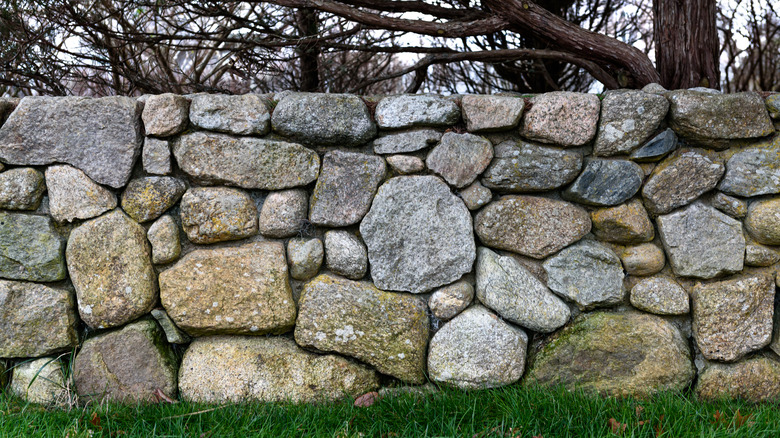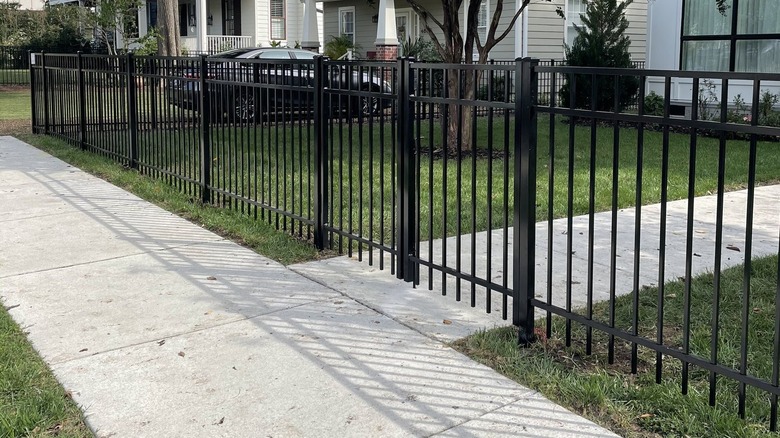The 6 Most Expensive Types Of Fence Materials (& Are They Worth The Price?)
A new fence does more than add style to homes and landscapes. Installing a fence can raise your home's real estate value, improve security and privacy, and add a personal touch to your property. The average wooden fence costs between $6 to $13 per linear foot. And, while the fence type is more affordable, wood doesn't have the same benefits as other materials that soar above that price.
Below are six types of fences that cost far more to build than a standard picket fence. Although many of these cost between $20 to over $50 per foot, depending on the material, design, and color, the pricing isn't just a thoughtless upcharge. When you pay more for fencing, you're usually paying for a sturdier material that potentially pays off in the long run. They typically don't need the same upkeep as cheaper fences, nor do they need to be repaired and replaced as frequently. Learn more below about what makes these fences so expensive and whether they're worth the investment.
Vinyl fencing can be worth the investment for its versatility and customization
Vinyl is one of the most popular plastics used in manufacturing because it's cost-effective, versatile, and potentially recyclable. It's no surprise this material is a staple in the fencing industry and, depending on the quality, it can range from budget-friendly to very expensive. Due to the versatility of the material, vinyl fences come in many designs; including privacy, picket, traditional, and trellis forms. They also come in many colors and patterns, and they're customizable with paint.
The catch with vinyl fencing is that the cost can vary wildly depending on what you choose. They range anywhere from $14 to $60 or more per linear foot depending on your preferences. Taller fences can increase your overall cost by over 25%. Choosing a black color also boosts the price, as a linear foot of black vinyl fencing can cost around $60. So, depending on how much customization you'd like, vinyl can be worth it for its versatility and the options available.
Fieldstone fences don't need much maintenance over the decades, but are pricey to repair or relocate
One of the most traditional fences in history is referred to as fieldstone. This style piles quarried and foraged natural stones on top of one another to make a rustic fence line befitting cottage and farmhouse-style homes. While they're usually installed around historical-esque buildings, the right stone colors and shades can also complement modern homes. These fences are defined by their irregularities and uneven texture, and they last for decades without needing much maintenance or touching up.
Depending on how tall you build your wall and what kinds of stones are used, they cost anywhere from $20 to over $60 per linear foot. When planned and built well, fieldstone doesn't typically need any supplemental materials, such as mortar. However, if you ever want to relocate or redesign this fenceline, it can be exorbitantly pricey. The stones are heavy and difficult to move, and hiring professional help is highly recommended. So, it's not the most cost-effective way to add a fence to your property, but it can be a good investment if you're looking for a durable and permanent solution.
Steel fences are heavy duty, but have high material and labor costs
If you're looking for a fence that is as strong as it looks, steel is the right choice. These fences are welded together, making them an imposing and secure barricade for property lines. It's nearly impossible to dismantle without putting work in, and the material itself is incredibly durable. When galvanized and powder-coated, it's also weather and rust-resistant.
Steel fencing is the fourth most expensive fence type on our list, costing between $23 to $45 per linear foot on average. The material is heavy, and often requires professional labor to install, making it pricier than a DIY vinyl or wood installation. Although this fence is incredibly sturdy and its composition holds up well against weather and rain over the course of years, the appearance isn't guaranteed. Over time, small scratches and dents may ruin the aesthetic of a steel fence. However, if security is your priority, the investment in steel can be worth the peace of mind. If not, then you're better off going with something more affordable but similar in appearance, like vinyl.
Aluminum fences are an investment but can last a lifetime
A mid-tier metal fence is aesthetically pleasing, resilient, and costly, but still feasible for many households. If you want a color aside from gray, many fence companies offer a powder coating that transforms the aluminum into an array of colors, including black, brown, green, white, or other customizable shades. It also comes in many designs and is relatively lightweight, making it a similar choice to vinyl in several aspects.
The price per linear foot ranges from about $24 to around $55. Like all fences, the price estimate fluctuates based on the fence design, height, landscape, and availability of material in your local area. Aluminum is rust-resistant, making it a great upgraded material for those who live in humid areas. It also doesn't need a lot of upkeep, saving you maintenance costs over time. Since it can last you decades without much intervening, the price tag can be worth it.
Composite wood is easy to upkeep, but requires more upfront costs and can fade over time
Wood material has a reputation for being affordable, readily available, and easy to install. However, composite wood is very different than traditional wooden fence types. This material is a blend of natural wood and plastic, providing several benefits over 100% hardwood products. The mixture makes it more weather and insect-resistant. As an added benefit, some composite wood fences have an FSC certification, meaning they're made using high environmental standards.
Composite wood typically ranges from $26 to $57 per linear foot. To compare, installing a traditional wood fence costs about $6 per foot at its cheapest and tops out at around $35. The initial installation cost is higher, but homeowners can save time and money in the long run since composite doesn't require much upkeep. While many fencing companies advertise this benefit, they tend to omit that composite wood can fade. Darker colors like black, brown, and gray are especially susceptible to sun-bleaching over time, and there's no way to completely restore it. Because of this, choosing a darker color might not be worth the cost if you have to replace it every decade for it to look fresh.
Wrought iron is top-of-the-line, and its price matches its durability and artistry
Wrought iron is top-of-the-line, and its price matches the extreme durability. Iron fences last for decades and never go out of style, as they've been common fences on American houses since the late 1800s. However, they don't have much variability in design, but the typical styles complement most homes. You can also paint wrought iron or have it powder-coated in an array of colors, such as black, gray, green, and other metallic shades.
Opting for wrought iron fencing is usually a heavy investment at around $28 to $56 per linear foot. This cost is partially because the material is more difficult to install and it requires a lot of labor to produce. But, this pays off by providing you with a durable, well-made material. However, the metal can suffer from rusting and corrosion, so you'll want to seal it regularly to keep it looking great and functioning well. This particular fencing can be worth the price if you want something extremely durable with a focus on craftsmanship and design. If that's not a priority, a more affordable option like steel might be a better fit.






